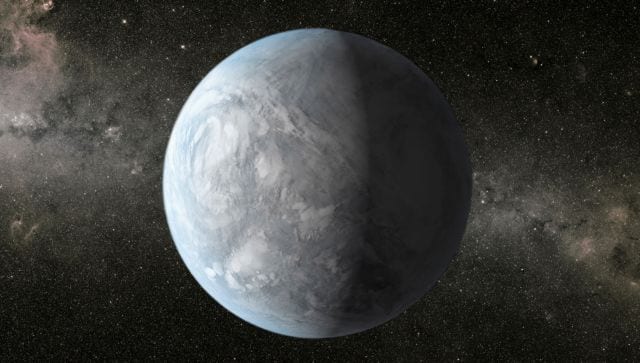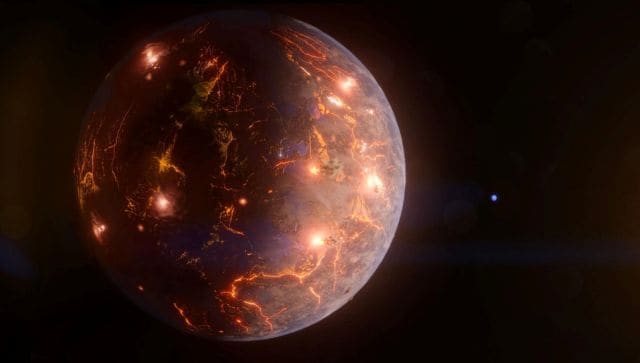An international team of scientists has discovered an exoplanet that has the same size as Jupiter and the highest density known so far. The team led by Professor Abhijit Chakraborty at the Exoplanet Research Group of the Physical Research Laboratory (PRL), Ahmedabad, included scientists from India, United States, Germany and Switzerland, according to a statement from Indian Space Research Organisation (ISRO). According to US’ NASA, thousands of exoplanets have been found since the first was detected in the 1990s. What is an exoplanet and what should you know about the new discovery? Let’s take a closer look. What are exoplanets? An exoplanet is a planet that orbits a star beyond the solar system. As per NASA, there are also exoplanets, known as rogue planets, that are not bound to any star but instead orbit the galactic centre.
According to Space.com, an exoplanet is also referred to as an alien planet as it orbits a star other than the Sun.
“Exoplanets are made up of elements similar to those of the planets in our solar system, but their mixes of those elements may differ. Some planets may be dominated by water or ice, while others are dominated by iron or carbon,” says NASA’s Exoplanet Exploration website. It is not easy to detect exoplanets directly through telescopes as they are concealed by the “bright glare of the stars they orbit”, as per the US space agency. [caption id=“attachment_12668372” align=“alignnone” width=“640”] An artist’s depiction of Kepler-62e exoplanet. Reuters (NASA handout)[/caption] How was the new exoplanet found? The exoplanet was found around the star called TOI4603 or HD 245134 using the PRL Advanced Radial-velocity Abu-sky Search (PARAS) spectrograph. “The discovery of this massive exoplanet was made using the indigenously made PRL Advanced Radial-velocity Abu-sky Search spectrograph (PARAS) at the 1.2 m telescope of PRL at its Gurushikhar Observatory in Mt. Abu by measuring the mass of the planet precisely,” India’s space agency said in its statement. Earlier, NASA’s Transiting Exoplanet Survey Satellite (TESS) had announced TOI4603 as a “possible candidate to host a secondary body of unknown nature”, it further said. This exoplanet has been dubbed TOI 4603b or HD 245134b as it was detected after scientists measured the mass of the secondary body. As India Today noted, the details of this discovery have been published in the journal Astronomy & Astrophysics Letters. The new exoplanet – 13 times bigger than Jupiter The mass or weight of the newly found exoplanet is 13 times that of Jupiter. Its density of ~14 g/cm3 is the highest known to date, noted ISRO. Located 731 light years away, the exoplanet orbits sub-giant F-type star TOI4603 every 7.24 days. One of the most massive and densest giant planets, TOI 4603b orbits pretty close to its host star at a distance less than one-tenth the length of space between the Sun and Earth, as per ISRO. ALSO READ:
NASA aims to enhance astronaut meals through the implementation of deep space food production
Why does the discovery matter? According to India’s space agency, this discovery is important as TOI 4603b “falls into the transition mass range of massive giant planets and low-mass brown dwarfs with masses ranging from 11 to 16 times the mass of Jupiter”. Massive giant exoplanets are those that have a mass more than four times that of the largest planet in the solar system.
An artist’s depiction of Kepler-62e exoplanet. Reuters (NASA handout)[/caption] How was the new exoplanet found? The exoplanet was found around the star called TOI4603 or HD 245134 using the PRL Advanced Radial-velocity Abu-sky Search (PARAS) spectrograph. “The discovery of this massive exoplanet was made using the indigenously made PRL Advanced Radial-velocity Abu-sky Search spectrograph (PARAS) at the 1.2 m telescope of PRL at its Gurushikhar Observatory in Mt. Abu by measuring the mass of the planet precisely,” India’s space agency said in its statement. Earlier, NASA’s Transiting Exoplanet Survey Satellite (TESS) had announced TOI4603 as a “possible candidate to host a secondary body of unknown nature”, it further said. This exoplanet has been dubbed TOI 4603b or HD 245134b as it was detected after scientists measured the mass of the secondary body. As India Today noted, the details of this discovery have been published in the journal Astronomy & Astrophysics Letters. The new exoplanet – 13 times bigger than Jupiter The mass or weight of the newly found exoplanet is 13 times that of Jupiter. Its density of ~14 g/cm3 is the highest known to date, noted ISRO. Located 731 light years away, the exoplanet orbits sub-giant F-type star TOI4603 every 7.24 days. One of the most massive and densest giant planets, TOI 4603b orbits pretty close to its host star at a distance less than one-tenth the length of space between the Sun and Earth, as per ISRO. ALSO READ:
NASA aims to enhance astronaut meals through the implementation of deep space food production
Why does the discovery matter? According to India’s space agency, this discovery is important as TOI 4603b “falls into the transition mass range of massive giant planets and low-mass brown dwarfs with masses ranging from 11 to 16 times the mass of Jupiter”. Massive giant exoplanets are those that have a mass more than four times that of the largest planet in the solar system.
Less than five exoplanets have been found in this mass range so far.
“The exoplanet with a surface temperature of 1670 K is likely undergoing high-eccentricity tidal migration with an eccentricity value of approximately 0.3 The detection of such systems provides valuable insights into the formation, migration, and evolution mechanisms of massive exoplanets,” the ISRO said in the statement. Moreover, this is India’s third exoplanet discovery made by PRL scientists with PARAS spectrograph and the PRL 1.2m telescope. The other discoveries were made in 2018 (K2-236b) and 2021 (TOI-1789b), according to India’s space agency. [caption id=“attachment_12668382” align=“alignnone” width=“640”] An artist’s depiction of an exoplanet that may be covered in volcanoes. Reuters (NASA handout)[/caption] Earlier this month,
NASA announced it has discovered an Earth-size exoplanet
that may be covered in volcanoes. “Called LP 791-18 d, the planet could undergo volcanic outbursts as often as Jupiter’s moon Io, the most volcanically active body in our solar system,” the space agency said. With inputs from agencies Read all the
Latest News
,
Trending News
,
Cricket News
,
Bollywood News
, India News
and
Entertainment News
here. Follow us on
Facebook
,
Twitter
and
Instagram
.
An artist’s depiction of an exoplanet that may be covered in volcanoes. Reuters (NASA handout)[/caption] Earlier this month,
NASA announced it has discovered an Earth-size exoplanet
that may be covered in volcanoes. “Called LP 791-18 d, the planet could undergo volcanic outbursts as often as Jupiter’s moon Io, the most volcanically active body in our solar system,” the space agency said. With inputs from agencies Read all the
Latest News
,
Trending News
,
Cricket News
,
Bollywood News
, India News
and
Entertainment News
here. Follow us on
Facebook
,
Twitter
and
Instagram
.
)